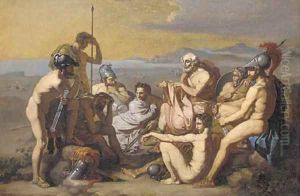Johann Martin Wagner Paintings
Johann Martin Wagner was a German artist, sculptor, and architect, born in 1777 in Oettingen in Bayern, Germany. His career spanned the early to mid-19th century, a period marked by significant transformations in European art, with the rise of Romanticism and the beginning of a shift towards modernism. Wagner is less known to the broader public compared to his contemporaries, but his contributions to art and architecture, particularly in Germany, were notable during his lifetime and continue to be studied by art historians.
Wagner's early life was shaped by his passion for art and architecture, leading him to pursue an education in these fields. He studied at the Academy of Fine Arts in Vienna, where he was exposed to the works of classical antiquity and the Renaissance, which would have a lasting impact on his artistic development. His style was characterized by a blend of classical ideals with the emerging Romantic sensibilities of his time, focusing on both aesthetic beauty and emotional expression.
Throughout his career, Wagner worked on various projects, including sculpture, architectural designs, and restorations of ancient monuments. One of his significant contributions was his involvement in the restoration and conservation of classical sculptures and buildings, which was part of a broader European interest in antiquity during the 18th and 19th centuries. This work not only reflected his skills as an artist and architect but also his dedication to preserving cultural heritage.
In addition to his practical work, Wagner also served as an academic and teacher, passing on his knowledge to the next generation of artists and architects. He held positions at prestigious institutions, where he influenced many students with his emphasis on the importance of classical traditions and the integration of new artistic ideas.
Johann Martin Wagner died in 1858, leaving behind a legacy that, while perhaps not as widely recognized as that of some of his peers, was significant in the context of German art and architecture. His works and teachings contributed to the development of 19th-century art, bridging the gap between classical traditions and the evolving modernist approaches that would come to define the future of European art. Wagner's commitment to the preservation of cultural heritage and his contributions to the artistic and architectural landscape of Germany underscore his importance as a figure in the history of 19th-century European art.

